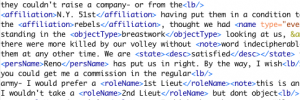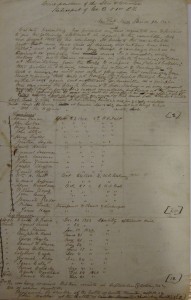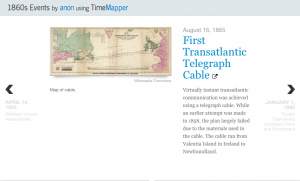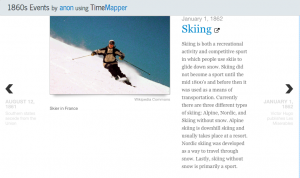
As my final project for Digging into the Digital, I chose to look at the letters James Merrill Linn wrote home from March 16 to 26, 1862. I chose these particular dates because they are the letters that he sent as the Battle of NewBern was taking place. In the archives, the diary entries that he would have written during this battle are missing. Either they were lost on the way to Bucknell University’s archives, or he did not write in his diary during the battle. Either way, the letters he wrote home are the only pieces of his first hand occurrence of the battle. My research question is “Do the letters he wrote from March 16 to March 26 actually help to make sense of what happened during the Battle of New Bern?
To get the most accurate answer to my research question, I chose to do close reading. I did not think mapping would be as helpful since I was not worried about the particulars of his location, but rather what was said in the pages. I thought that this would be the most helpful because I could compare it to the diary entries before and after the battle, to see if it does accurately fill in what happened during the battle of New Bern. I was given ten letters from the archives to do a close reading of. I transcribed eight letters written to his brother, John that look like the page shown in Figure 1.
I did not find transcribing the pages too strenuous but I did come across a few difficulties in the letters. In one letter, he must have spilled water on the corner of the page because part of the first line was illegible due to

water damage (Figure 2). There were only a few words that I could not decipher. The majority of my difficulties came from words that Linn used that I have never heard before and had to look up, or words that I have never heard in that context before. The most interesting example of this is in Figure 3 where Linn writes, “I have an altered Harpers ferry which is boxed to send from here”. I had never heard of a ferry that you can box and send home before, so I turned to the Internet to do some research on “Harpers ferry”. At first I came up empty-handed, all the sites said was that this was a National Historic Park of a historic town in West Virginia. However, when I added the word “gun” to my search, it revealed that Harpers ferry was the first rifle made by an American armory.

After transcribing the letters, I began to analyze them through TEI. I put the transcriptions into Oxygen and marked them up. We did the same for Linn’s diary entries in the beginning of the year so I was able to compare his letters to John during the battle of New Bern to other diary entries he wrote. While tagging the letters I noticed a few different things than when tagging the diary. I do not think we used the “affiliation” tag at all  during the tagging of the diaries. This time around I used it much more often though. Such as when tagging his company, or the rebels, or anything that refers to a formal relationship with a group of some kind. I also used the “state” tag very often this time around. I think this is because the letters he wrote home to his family are much more personal than what he wrote in his diary. Most likely because he wrote this diary for himself for the future, or for the public to read so he doesn’t put more facts into it than his emotions.
during the tagging of the diaries. This time around I used it much more often though. Such as when tagging his company, or the rebels, or anything that refers to a formal relationship with a group of some kind. I also used the “state” tag very often this time around. I think this is because the letters he wrote home to his family are much more personal than what he wrote in his diary. Most likely because he wrote this diary for himself for the future, or for the public to read so he doesn’t put more facts into it than his emotions.
The letters he wrote to John are not as factual, although he wrote about the dates a lot. Most likely because Linn constantly wanted his brother to know what he was doing and where he was going. He also wrote more about generals and the men higher up in the ranks, rather than his comrades, unlike what he wrote in the diaries. I think this is because the diaries are for him personally and he knows who the comrades he is writing about are. John does not know the soldiers fighting alongside James, so he wrote more about the men who tell him and his comrades where to go and what to do. For example he never once mentioned his friend and fellow soldier Beaver in the eight pages that I transcribed, while in the diary he talked about him more than anyone else. Linn wrote about home much more often in the letters than in the diary. He talked about sending relics home, like an altered Harpers ferry, sending money home, and the letters he receives from his family. One part that I found very interesting was when he wrote, “My don’t Annie or Laura write. I have not received anything from them for a long while. I am glad the old shop is gone, though I think you let it go cheap”. In all the diary entries I read, he barely mentioned his sisters, but in a letter to his brother he did. Also, he wrote of events going on at home, something he would rarely do in the diary entries.
Since his diary entries are much more factual than the letters this might seem unfortunate because I am trying to see if the letters written in this time period fill in what happened at the battle of New Bern. I do not have as much information as I would have in a diary entry about this battle, because he writes more about what is affecting him in the battle, and especially the annoyances. One was when he “loaned a pair of my boots to a little Jew belonging to my company, but he disgraced them by blacking out in the battle”. Fortunately, we do have facts about the battle besides through these letters to John.
 The first two letters, on March 16, were solely focused on the events that unfolded during the battle of New Bern. These letters were not to his brother John, but to a newspaper from his hometown of Lewisburg, called the Star & Chronicle. Captain Hassenplug asked Linn to forward to the newspaper the casualties, loss, and present state of his company. Linn wrote that more have died of disease than have been killed in battle. He also wrote of their advances, attacks, and retreats. On the top of one of the pages Linn wrote “Recapitulation” and gave a summary of who dies, who transferred, who was discharged, who deserted the company, and who was wounded and where they were hurt. He even dedicated a whole paragraph to experiments that him and his company performed in light of the sentence “I have often been reminded of the remark we often hear that it is a wonder so many escape”. Linn thought the newspaper would find their experiments of firing funs at different ranges, and the accuracy of the guns to be interesting.
The first two letters, on March 16, were solely focused on the events that unfolded during the battle of New Bern. These letters were not to his brother John, but to a newspaper from his hometown of Lewisburg, called the Star & Chronicle. Captain Hassenplug asked Linn to forward to the newspaper the casualties, loss, and present state of his company. Linn wrote that more have died of disease than have been killed in battle. He also wrote of their advances, attacks, and retreats. On the top of one of the pages Linn wrote “Recapitulation” and gave a summary of who dies, who transferred, who was discharged, who deserted the company, and who was wounded and where they were hurt. He even dedicated a whole paragraph to experiments that him and his company performed in light of the sentence “I have often been reminded of the remark we often hear that it is a wonder so many escape”. Linn thought the newspaper would find their experiments of firing funs at different ranges, and the accuracy of the guns to be interesting.
Ultimately, transcribing Linn’s letters during the battle of New Bern did help me to comprehend the events that unfolded as Linn and his company were in the battle and the aftermath of it. Close reading allowed me to understand what happened during the battle, and also to look at how Linn wrote his letters compared to in his diary. I thought that this project was extremely interesting, and I enjoyed transcribing the letters to figure out how Linn wrote his letters home. It was also very fascinating to read the letter to the Star & Chronicle because it is very different from everything we have looked at in class. Overall, this project allowed me to have a better understanding of the battle of New Bern, and Linn’s writing techniques.
Links to my marked up files:
http://www.students.bucknell.edu/projects/HUMN10002/Wigginton/content/Wigginton_final.xml
http://www.students.bucknell.edu/projects/HUMN10002/Wigginton/Wigginton_file.xml
Works Cited
Linn, James Merrill. Letter to Star & Chronicle. March 16, 1862. MS. Bucknell University Archives and Special Collections, Lewisburg, PA.
Linn, James Merrill. Letters to John. March 19-26, 1862. MS. Bucknell University Archives and Special Collections, Lewisburg, PA.
Linn, James Merrill. Diary. March 12, 1862. MS. Bucknell University Archives and Special Collections, Lewisburg, PA.
Linn, James Merrill. Diary. March 24, 1862. MS. Bucknell University Archives and Special Collections, Lewisburg, PA.




 not mention any important historical events that occurred outside his life in the Civil War. For example, skiing was invented in the same winter when Linn was writing in his diary. Although he did not have the Internet or any technology that would have allowed him to gain access quickly, I assume that word of a new sport like skiing would have been spread about in the United States as well, but there was no mention of skiing or any important event that occurred outside of his immediate realm.
not mention any important historical events that occurred outside his life in the Civil War. For example, skiing was invented in the same winter when Linn was writing in his diary. Although he did not have the Internet or any technology that would have allowed him to gain access quickly, I assume that word of a new sport like skiing would have been spread about in the United States as well, but there was no mention of skiing or any important event that occurred outside of his immediate realm.